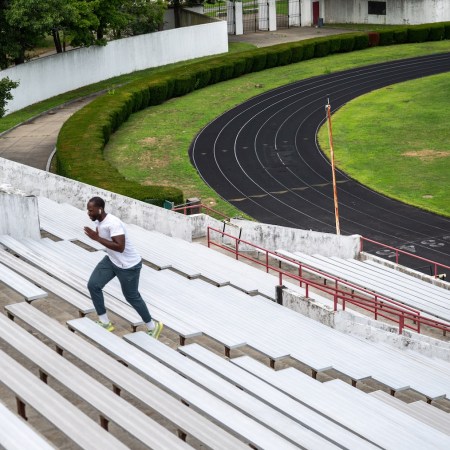Contrary to what you might have heard, sitting is not the new smoking.
Smoking firmly remains smoking, and continues to rein triumphant in the “premature death” sphere — it increases your risk by 180%, compared to <20% for cases of excessive sitting (defined as more than eight hours a day).
Still, the majority of us do sit at least six hours a day, and in recent years, the American average has soared up to the eight-hour mark. It’d be one thing if we spent those stationary minutes reading, chopping it up with friends or pursuing passions, but obviously, that’s not the case. We’re working, or decompressing from working.
To say nothing of the mental health woes that accompany a motionless life, there are legitimate physiological concerns: high blood pressure, high blood sugar, obesity, osteoporosis, blood pooling in your lower half or feet, back pain. Contorting your spine into the same workstation, every single day, regardless of its ergonomic clout, is no way to reel in the years.
Do “Exercise Prescriptions” Actually Work?
Some physicians are pushing patients towards hikes, not pillsUnfortunately, it’s also not much of an option. According to research from 2020, 80% of contemporary jobs could now be classified as “sedentary.” And on the other side of the spectrum: “the total of jobs involving at least moderate physical activity has dipped from 50 percent in 1960 to 20 percent today.”
There’s a Gladwellian take somewhere in there; perhaps “willingness to sit long hours” should now be listed as a job requirement.
It’s not like people haven’t been aware of the problem. Workplace gurus now advocate for sit-to-stand desks, move-around breaks every 30 minutes and lunchtime constitutionals. But it’s simultaneously A) demoralizing that we have to institutionalize the concept of getting up from a chair once in a while, while B) probably time for all of us to have additional, weightier, anti-sedentary tricks up our sleeves.
Sedentary stretches are going to keep coming, regardless, for decades upon decades. Your best defense is implementing routines that are equally non-negotiable to all the work, yet have you up and on your feet, or rolling out your back, or stretching your hip flexors. Think: Tai Chi, Chirp wheels, a devotion to earlier wake-ups (granting you the time to walk your dog, go for a run, jump in the ocean…flat-out move in whichever way comes easiest and most natural to you).
If you’re really keen on warding off the sedentary demons, consider graduating to a few key exercises, too, all of which can be performed on a simple yoga mat. Physical trainer Dan Go recently posted a handy thread with demonstrations of various moves that ward off the perils of life at the desk, including the McGill Crunch, side plank holds, activated bird dogs, glute bridge holds, bar hands, and the cat-cow pose.
Too often — and this applies to even the “fittest” among us — we cycle between doing absolutely nothing (padding away at the keyboard) to sprinting through a rip-roaring workout class. HIIT sessions and track workouts and Peloton climbs are all great, but our sedentary bodies truly stand to benefit from gentle stretches and splays.
Think: back-protecting adjustments that engage the core, coax ligaments out of taut slumber and remind the body how to move again. At a time when quiet-quitting employees are looking to get something back from their employers, try giving yourself something first — a dedication to movement, every day. It’ll pay better than any raise in the long run.
The Charge will help you move better, think clearer and stay in the game longer. Subscribe to our wellness newsletter today.



















